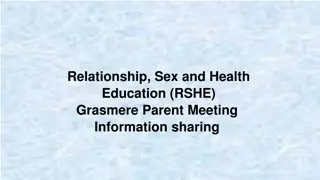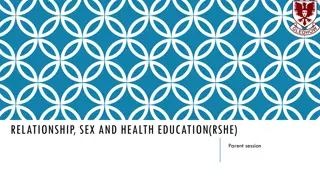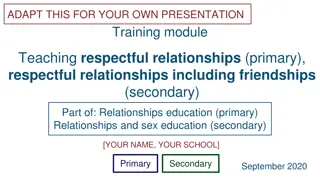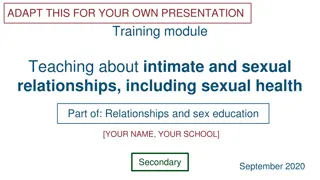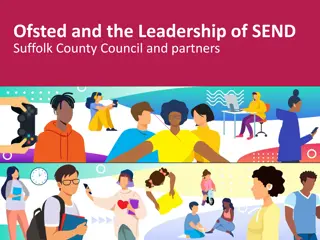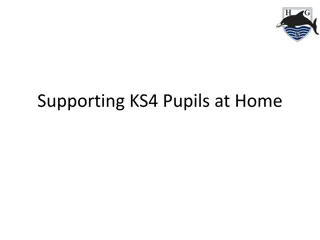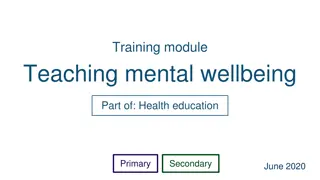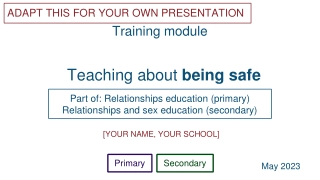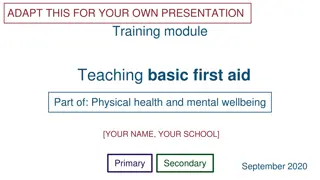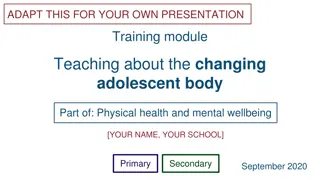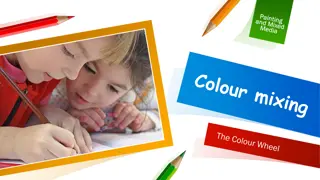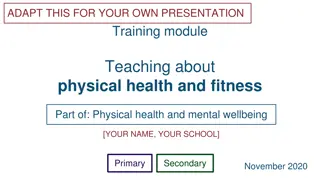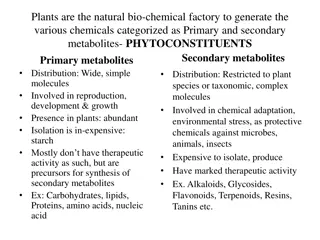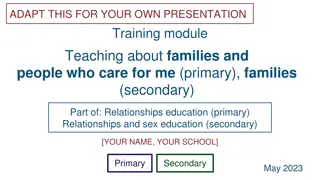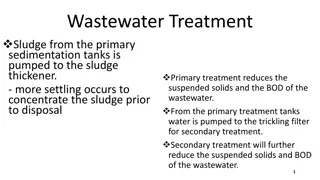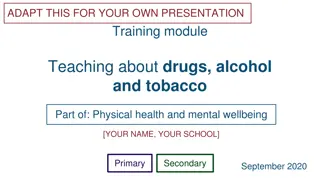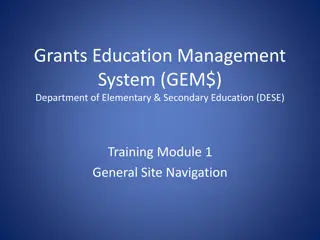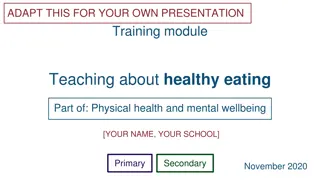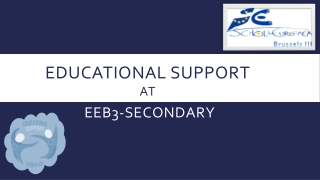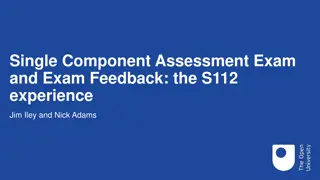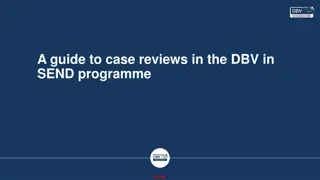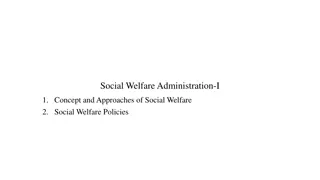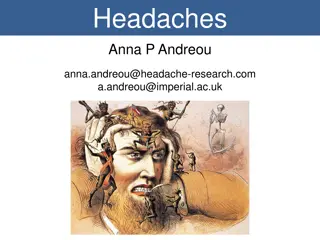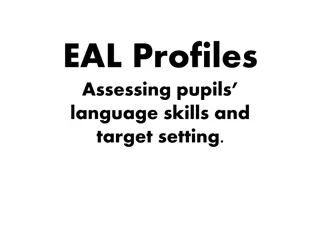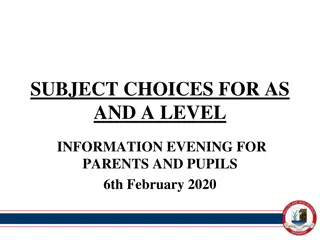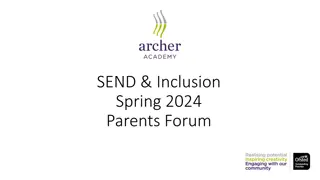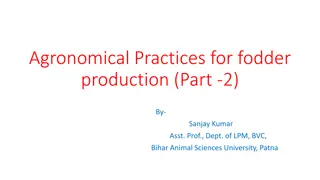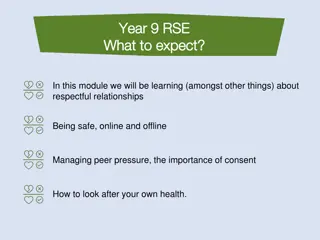Training Module: Teaching RSHE to Pupils with SEND - Relationships Education for Primary and Secondary Levels
This training module focuses on equipping educators with the necessary skills to teach Relationships, Sex, and Health Education (RSHE) to pupils with Special Educational Needs and Disabilities (SEND). It covers understanding duties towards SEND pupils, recognizing challenges they may face, and exploring approaches to address these challenges effectively. The module includes specific duties, related guidance, support resources available at the school, and safeguarding protocols. Subject leads can utilize the adaptable slides and activities provided to customize training sessions for teachers efficiently.
Download Presentation

Please find below an Image/Link to download the presentation.
The content on the website is provided AS IS for your information and personal use only. It may not be sold, licensed, or shared on other websites without obtaining consent from the author. Download presentation by click this link. If you encounter any issues during the download, it is possible that the publisher has removed the file from their server.
E N D
Presentation Transcript
ADAPT THIS FOR YOUR OWN PRESENTATION Training module Teaching RSHE to pupils with SEND Part of: Relationships education (primary) Relationships and sex education (secondary) [YOUR NAME, YOUR SCHOOL] Primary Secondary March 2021
Contents 3 About this training module 7 Safeguarding 14 Ground rules 16 General guidance 35 Communication and interaction needs 40 Cognition and learning needs 51 Social emotional and mental health needs 57 Sensory and/or physical needs 64 Sources 67 Activities and templates for trainers 2
What you get out of today By the end of this training you should: understand your duties regarding SEND and relationships, sex and health education recognise some of the challenges pupils with SEND may face in these subjects appreciate some of the approaches you might take to mitigate these challenges Subject leads can use the adaptable slides and activities and templates for trainers section at the end of the module to help shape training sessions for teachers. It is not suggested that all slides in this module are used in a single training session. 3
Specific duties regarding SEND Schools have a requirement to ensure that the needs of all pupils, including pupils with SEND, are met. It is important to emphasise that the teacher is responsible for meeting these needs and that support staff work under their guidance. Specific duties are set out in the Equality Act and the SEND code of practice. 4
Related guidance Schools may also want to refer to the following related guidance when delivering this module: Statutory guidance: Relationships and sex education (RSE) and health education Teaching about relationships, sex and health SEND Code of Practice 5
Support at [school name] Our leads [Names, contact details of first aid leads] Our policies [Add details e.g. school policy on PSHE, training opportunities] Specialist support [Add details e.g. SENCO, providers with whom the school already works] Other information [Add resources] 6
Trusted adults Within this module we have used the term trusted adult. A trusted adult will generally be someone who children feel comfortable to turn to for help. Obvious examples include family members, teachers and doctors. It will be important when teaching this topic, and any other relevant topics, that teachers explore this concept. Pupils should be comfortable and capable of identifying who their trusted adults could be both within their families and wider circles. 8
Safeguarding and pupils with SEND (1) Safeguarding is possibly the most pressing argument for teaching relationships, sex and health education to pupils with special educational needs and disability (SEND) who are, generally, more vulnerable to abuse, bullying, exploitation and other issues because of their SEND. Pupils with SEND may need extra help to deal with peer pressure and coercion. Pupils may be affected by issues discussed in lessons. Let your designated safeguarding lead or deputy and any other relevant staff, such as pastoral leads, know what you are teaching. This will enable them to identify and speak to relevant pupils, especially those who they know may have been directly impacted by issues covered in the lessons and those with adverse childhood experiences. 9
Safeguarding and pupils with SEND (2) When ground rules are set, and at the beginning of every lesson, make it clear that some pupils may find the content challenging and suggest trusted adults they could approach after the lesson to talk more about the content. At the start of each lesson, remind pupils of the need to respect privacy. Pupils with SEND may need to be explicitly taught what is meant by privacy, giving examples that may not necessarily relate to relationships, sex and health education. Pupils can discuss examples but must not use names or descriptions that identify anyone, including themselves. Consider pupils who struggle with their emotional regulation. Alongside revisiting ground rules, start each lesson with a check-in on feelings. Offer mini breaks or other strategies during the session for those who need them. 10
Safeguarding and pupils with SEND (3) Have the Childline number, website and email on display should any pupil wish to access support outside of school. To further support SEND pupils, consider putting this information on a sticker in their planner at the start of the first lesson. This can then be referred to in each lesson as a reminder. Explain to pupils what Childline is and how to contact them. It may be useful to roleplay a call to Childline and to demonstrate navigating their website. It may also be useful to identify a trusted adult within the home that pupils can speak to. 11
Questions Due to the nature of their needs pupils with SEND may be more disinhibited than mainstream peers and may ask explicit, intrusive or inappropriate questions. Establish appropriate boundaries as part of ground rules and ensure that staff teaching this subject can respond with confidence. If necessary, teachers can offer to answer questions in a later session, and seek advice from colleagues. Consider having a box in which pupils can post anonymous questions to be answered during the subsequent lesson. Be aware that this approach may exclude pupils who struggle with writing and these pupils may need support from a teaching assistant. 12
Disclosures Teachers may need to deal with disclosures or concerns (e.g. of abuse or offending behaviour) in a way that safeguards pupils in line with school policies, especially the child protection policy. Create a clear process for disclosures that all staff are aware of and emphasise identifying a trusted adult pupils can speak to if they have more questions. If a pupil makes a disclosure during the lesson, ensure that it is dealt with immediately by someone who knows them well (pupils with learning difficulties may not be able to retain the information until the end of the lesson). Use photographs of school staff members alongside their names, to reinforce the identity of people who pupils can talk to after the lesson if they have any concerns or worries. 13
Ground rules 14
Additional ground rules for pupils with SEND Ground rules are discussed in each module. You may need to establish additional ground rules when teaching pupils with SEND and to refer to these ground rules at the beginning of every lesson. Suggested approaches include: identifying public vs. private acts and spaces including emphasising that the classroom will be changed from a public space to a space where pupils may discuss private issues setting Behaviour for Learning targets discussing appropriate and inappropriate questions (for example, personal or intrusive questions vs. questions about the content) emphasising the need for self-control and explicitly teaching what this means (particularly where pupils might be embarrassed by the content) 15
Focus on individual needs Before teaching relationships, sex and health education, teachers should work with the special educational needs coordinator (SENCO) to identify pupils with SEND and to be sure of what their individual needs are. CODE OF PRACTICE Early years providers, schools and colleges should know precisely where children and young people with SEN are in their learning and development. 1 The purpose of identification is to work out what action the school needs to take, not to fit a pupil into a category. In practice, individual children or young people often have needs that cut across [the broad areas of need] and their needs may change over time. 2 1. Special educational needs and disability code of practice: 0 to 25 years, p25 2. Special educational needs and disability code of practice: 0 to 25 years, p97 17
Importance of RSHE to pupils with SEND (1) Historically, some pupils with SEND have felt excluded from relationships, sex and health education. For each lesson, consider whether pupils will feel excluded, and make sure you address their needs. Pupils with SEND are generally more vulnerable to abuse, bullying and other issues because of their SEND: in 2019, 37% of pupils with SEND reported being bullied based on other pupils attitudes or assumptions towards their SEND at least once in the past year. (source: DfE report) in 2012, Jones et al concluded that children and young people who have disabilities are at an increased risk of being abused compared with their non- disabled peers (source: NSPCC). For more on preventing abuse, see the being safe module. 18
Importance of RSHE to pupils with SEND (2) Pupils with social, emotional and mental health (SEMH) needs or learning disabilities can especially benefit from relationships, sex and health education. In particular, a focus on friendships and healthy relationships and how this can impact on emotional wellbeing. In addition, this focus on healthy relationships must be taught explicitly and referred to at appropriate points throughout as pupils with SEND can be vulnerable to abusive relationships (including mate crime where people with SEND are targeted and befriended for financial abuse). Pupils with SEND may not have the skills required to identify when a friendship or relationship is unhealthy. For example, they may not recognise coercive relationships. For more on coercion, see the respectful relationships module. 19
LGBT needs and inclusion Primary schools are enabled and encouraged to cover LGBT (lesbian, gay, bisexual and transgender) content if they consider it age appropriate to do so. Secondary schools should include LGBT content. When doing so, schools should ensure: LGBT-relevant knowledge and examples are included throughout programmes of study (not one-off teaching) inclusive language is used, considering how individual pupils may relate to particular topics SEND can add to the challenge of supporting pupils who are exploring their identity. This increases the need to provide additional support to staff and families. 20
Preparing for adulthood outcomes You might want to link lesson outcomes with statutory preparing for adulthood outcomes for those with an education, health and care (EHC) plan. (See SEND code of practice, section 8.) In particular you may want to consider outcomes such as: participating in society including having friends and supportive relationships, and participating in, and contributing to, the local community being as healthy as possible in adult life 21
Teacher wellbeing You may need to be more practical and explicit when teaching some pupils with SEND and these pupils can lack social barriers. It is therefore especially important to consider the safeguarding needs of staff delivering the lessons. Talk to your line manager, in the first instance, if you do need support. 22
Whole school approach and cross-curricular links (1) Use informal opportunities for teaching (such as queueing at lunchtime or performing care routines) as well as formal ones. Activities should be practical and, wherever possible, in context. Embed policies that apply to the whole school, including language, privacy and touch. Include all school staff in the training of relationships, sex and health education for pupils with SEND, including teaching assistants, newly qualified teachers (NQTs) and other support staff. Be aware that NQTs in particular might struggle with delivering these topics to pupils with SEND. 23
Whole school approach and cross-curricular links (2) Ensure that the whole school is invested in the quality of relationships, sex and health education for all pupils, including pupils with SEND, as part of pupils personal development and preparation for independent living. Life skills covered in these lessons can be particularly useful for pupils with SEND. This should be reflected in the school s relationships, sex and health education policy. Identify opportunities for cross-curricular links; this is vital for reinforcing key messages and consolidating understanding. 24
General approach (1) STATUTORY GUIDANCE High quality teaching that is differentiated and personalised will be the starting point to ensure accessibility. (p15) Ensure that teachers and teaching assistants assigned to deliver relationships, sex and health education to pupils with SEND are confident and comfortable with the content, and with teaching this material to pupils with SEND. If your school has no single teacher who is confident and comfortable with the content, consider dividing the material between teachers who are confident with particular modules or team teaching sensitive topics. It is paramount that teaching is presented neutrally and without judgment. Pupils with SEND must not be made to feel ashamed of their sexual needs and desires. 25
General approach (2) Set the tone and establish ground rules to build a safe environment which encourages pupils to ask questions and express their thoughts. This is particularly important for those pupils with SEND who may lack maturity and need to be given the tools to be able to take part in these lessons appropriately. As mentioned above, pupils with SEND are generally more vulnerable to abuse, bullying and other issues. They will need to feel that the classroom is a safe space where they are able to explore the topic without fear of ridicule or judgement from their peers. 26
General approach (3) When the needs of pupils in the classroom suggest it, consider supplementing the approach with alternatives to classroom teaching, such as digital approaches, one-to-one discussions, small-group sessions, or targeted sessions for some pupils. This can help to teach key vocabulary or concepts that pupils may not understand, consolidate learning, and ensure content has been understood. It also gives an opportunity for personalised teaching to meet specific needs. For some pupils with SEND, it may be necessary to repeat lessons in order to consolidate understanding. If possible, consider using learning support assistants to provide support and facilitate pupils emotional regulation (for example, by taking short breaks away from the classroom). 27
General approach (4) Adapt desired learning outcomes according to the different needs of your pupils. It may be helpful for some pupils to use a task plan so they can see where the lesson is going. This can also act as a tool to reduce any anxiety or behaviour issues by incorporating breaks where appropriate. Consider explicitly preparing some pupils ahead of difficult topics where their particular needs might make this necessary. Discuss how these pupils might handle any discomfort and how staff can support them. Visual timetables may help some pupils with SEND to understand when relationships, sex and health education lessons are scheduled and help them to be mentally and emotionally prepared. 28
Assessing pupils readiness for a topic Knowing the children in a given lesson is key to assessing their readiness for a particular topic. Wherever possible decisions on pupils readiness should be made by staff who know them well. This understanding can be deepened through careful questioning and assessment. encourage pupils to tell you what they already know about the topic find out what areas of the topic they may need support with consider how they have dealt with other topics that may be less challenging make sure your approach to assessing readiness is clear and succinct; if appropriate for your pupils use visuals to support text when assessing where you are unsure how a pupil might react to a topic, discuss with parents the best approach and ensure they are aware of when the subject is being taught 29
Language and inclusion (1) Use inclusive language. Convey to pupils with SEND the message that their needs are important and they deserve to learn this material. Provide pupils with resources that are representative of a variety of SEND (and feature different ethnicities, sexes, and sexualities). Use medically/scientifically correct language to accurately describe human anatomy and the processes of the body. Consider providing a glossary that explains the terms used (including pictures) and lists alternative language such as slang. Use straightforward, explicit explanations and language. Avoid euphemisms some pupils with SEND may not understand them. Reinforce explanations visually wherever possible. 30
Language and inclusion (2) Consider using narrative, for example role play or social stories. When introducing a topic, develop the narrative by introducing and building fictional characters who will go through various experiences relating to the topic. The narrative can be used to support and develop understanding for pupils with SEND. Put each important concept into the story. Include key words and terms, and refer back to them throughout the lesson using the narrative. For some pupils it may be useful to develop their own physical character (using a blank body template) and to use this character when referring to the topics covered. Note that this approach may be problematic when pupils exhibit literal thinking. 31
Involving parents and carers Good quality relationships, sex and health education for pupils with SEND is dependent on parental engagement so that messages can be reinforced in all settings. Communicate regularly with parents and carers and keep them informed on upcoming topics. Consider running a Q&A meeting especially for parents of pupils with SEND. Discuss the importance of teaching about healthy relationships, especially for pupils with SEND. Explain that the focus of this teaching is on how to stay safe in a relationship, what constitutes a healthy relationship and coercive relationships. To consolidate learning, send home simple straightforward homework to help parents and carers to support pupils. An example may be a card sort with visuals: what is/is not a good friend. Consider providing support to help parents and carers to answer difficult questions or to understand risks. 32
Grouping pupils (1) In mainstream schools, the complex needs of some pupils may make it impossible to keep all pupils with SEND in the lesson, but when taught separately pupils with SEND will miss out on the benefits of discussion time with the other pupils. Pupils with SEND (as discussed elsewhere in this module) may also benefit from additional lessons on building healthy relationships and recognising healthy and unhealthy relationships. Consider whether the benefits of group discussion outweigh the need to tailor teaching to ensure understanding or to create a safe space to explore difficult topics. Aim for a balanced approach. 33
Grouping pupils (2) If possible, arrange learning into smaller groups to meet different needs more effectively. Assess the advantages and disadvantages of each type of grouping that you are considering for your cohort of pupils. This will need to be handled sensitively so pupils do not feel singled out because of their SEND. 34
Definition (1) CODE OF PRACTICE Children and young people with speech, language and communication needs (SLCN) have difficulty in communicating with others. This may be because they have difficulty saying what they want to, understanding what is being said to them or they do not understand or use social rules of communication. The profile for every child with SLCN is different and their needs may change over time. They may have difficulty with one, some or all of the different aspects of speech, language or social communication at different times of their lives.1 1. Special educational needs and disability code of practice: 0 to 25 years, p97 36
Definition (2) CODE OF PRACTICE Children and young people with autism spectrum disorder (ASD), including Asperger s Syndrome and Autism, are likely to have particular difficulties with social interaction. They may also experience difficulties with language, communication and imagination, which can impact on how they relate to others.1 1. Special educational needs and disability code of practice: 0 to 25 years, p97 37
Language and vocabulary Some of the vocabulary in the materials is difficult. Use simple, clear, unambiguous language alongside key technical vocabulary. Pre- and post-teach key vocabulary explicitly using visuals, concrete objects, word mats, and role play. Concepts such as friend may need to be explicitly taught, as may the concepts of public and private (which need to be explicitly revisited when ground rules are presented at the beginning of each lesson). Visually reinforce all key messages wherever possible, and use visual prompts where appropriate. Consider specialist resources such as Augmentative and Alternative Communication (AAC) support tools. 38
Assessing progress Be constantly aware of the levels of understanding. Use a variety of apparatus to explore and explain the concepts, to increase comprehension. To support SEND pupils to participate while still assessing their understanding, pupils can hold up visual prompt cards. For example, true/false cards or yes/no cards. 39
Definition - cognition and learning needs (1) CODE OF PRACTICE Support for learning difficulties may be required when children and young people learn at a slower pace than their peers, even with appropriate differentiation. Learning difficulties cover a wide range of needs, including moderate learning difficulties (MLD), severe learning difficulties (SLD), where children are likely to need support in all areas of the curriculum and associated difficulties with mobility and communication, through to profound and multiple learning difficulties (PMLD), where children are likely to have severe and complex learning difficulties as well as a physical disability or sensory impairment.1 1. Special educational needs and disability code of practice: 0 to 25 years, p97-98 41
Definition - cognition and learning needs (2) CODE OF PRACTICE Specific learning difficulties, affect one or more specific aspects of learning. This encompasses a range of conditions such as dyslexia, dyscalculia and dyspraxia.1 1. Special educational needs and disability code of practice: 0 to 25 years, p97-98 42
Assessing development and understanding Cognitive development will not necessarily correspond to chronological age or key stage. You must conduct detailed individual assessments before teaching, to ascertain what has been retained, decide on age-appropriateness, and identify gaps in the learning. Physical development may be ahead of cognitive development. This can be particularly relevant to topics regarding puberty and may increase the likelihood of abuse. Topics such as puberty may be especially challenging for some pupils; consider preparing them for these topics ahead of lessons. Teachers should regularly check for understanding. Social stories are invaluable in ascertaining a pupil s level of understanding about the grey areas. Use narratives to support understanding. 43
Delivery approach (1) When pupils with cognition and learning needs are present, some topics will need to be broken down and taught over a longer period of time. Reduce the amount of content in each lesson, and focus on a key question or theme (e.g. What is a healthy relationship?). Revisit key themes (such as friendships or relationships) frequently and discuss their relevance to the current lesson. Much of the learning may need to be regularly revisited and consolidated. Some children with learning difficulties can lack social barriers and may be very explicit in discussions teachers need to be sufficiently experienced and confident to handle this safely while still encouraging pupils to engage and ask questions. 44
Delivery approach (2) Assess pupils with SEND in a lesson and consider whether approaches may need to favour discussion and other approaches over written work. Practical demonstrations by the pupils may be necessary to demonstrate understanding. Physical, realistic resources are especially important e.g. deodorants, knickers, condoms, diaphragms, realistic models of penises and vaginas/vulvas. As mentioned above, consider using narrative and relate the topic to the life experiences of the characters. For example, Sarah has started her period and needs to use a sanitary pad . Have a real packet of sanitary pads for pupils to touch and feel. 45
Delivery approach (3) To support understanding of puberty, consider using a timeline. Pupils can be invited to bring in pictures of themselves at different stages in their lives to add to the timeline. Alternatively, use a fictional narrative pointing out the differences at each stage. Include references to different social activities and increasing independence. Be mindful of those pupils who have very little independence due to their care needs. 46
Literal thinking (1) Some pupils with SEND are very literal in their understanding. It may be necessary to be more explicit with them and to avoid euphemism. Activities need to be practical and, wherever possible, performed in context / in situ. Reinforce key concepts from lessons at other times. For example, discuss healthy food choices at lunchtime or personal hygiene after PE lessons. Try to refer to emotions as pupils are experiencing them. For example, highlight the difference in emotions felt after breaktime to those after a long lesson. Tools and visual aids may help pupils who struggle with emotional learning to express themselves. 47
Literal thinking (2) Lifelike, realistic, representative resources are essential where pupils exhibit literal thinking. These approaches can be supported with social stories or narratives as discussed above. 48
Lifestyle (1) A significant number of pupils with learning difficulties have very little freedom. Therefore, almost all risk comes from within the family or online. Parents and carers may need to be informed that the digital skills of pupils with SEND may be far more advanced than their skills in other areas, this leads to increased risk. Some pupils with SEND may struggle to recognise when an online contact is misrepresenting themselves. This discernment may be difficult to teach; parents and carers will need to use the necessary parental controls and supervise or monitor their child s online activity. Online safety must be reinforced in every module wherever possible. Teachers may like to refer to the SEND specific online safety toolkit at https://www.childnet.com/resources/star-send-toolkit. 49
Lifestyle (2) Because of this lack of freedom, some pupils may find it harder to access help or support. Remind pupils of the staff members they can talk to in school (and show photographs of these staff members as mentioned above). 50


